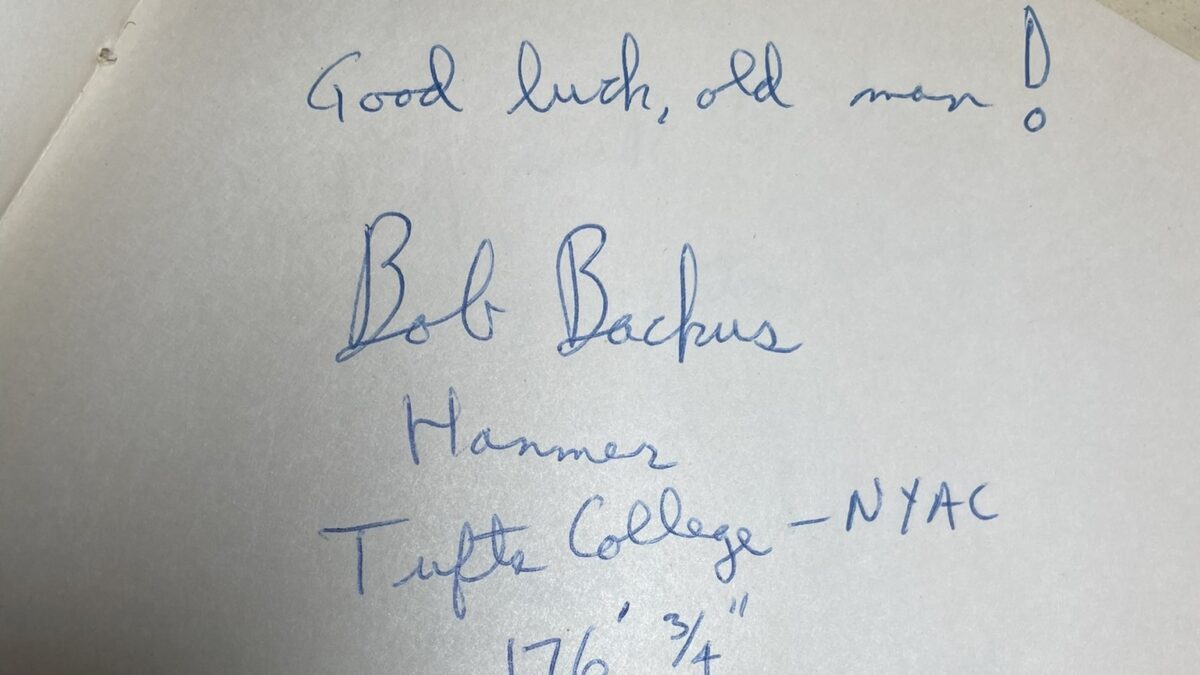
Like many Olympic athletes, Bob Backus overcame adversity. For him, it was spinal meningitis. Although he tried to join the Army Air Corp during World War II, they disqualified him for being too thin. In 1948, Bob Backus stood six feet five inches tall and weighed only 160 pounds. Most coaches and athletes avoided weightlifting at that time out of fear of becoming “muscle bound.” Backus used weight training to increase his weight to 290 pounds.
At Tufts University, Backus began throwing the hammer with sixteen-, thirty-five-, and fifty-six-pound weights. Although not officially recognized, he held the world record in the last two events. Today, athletes only throw a sixteen-pound hammer.
Robert “Bob” Backus lived in Marshfield, Massachusetts, and represented the New York Athletic Club when he qualified for the Olympics in 1952. Before boarding their Super-6 Clipper in New York to begin their long flight to Finland with the rest of the team, Thane and Bob Backus stood next to one another in a photograph taken by Pan American Airlines.
Throwing shoes did not exist during the 1952 Olympics. Backus wore men’s ballet shoes while he competed.
At the Helsinki Olympics, Backus placed thirteenth in the hammer throw. While he was there, he met Elsa Torikka of Finland, who placed seventeenth in the women’s javelin, and whom he later married.
Backus continued to throw, and at age fifty-one, finished second in the indoor national championships. He owned a gym in Massachusetts and helped the New York Yankees in their 1983 spring training.
In this writer’s mind, the hammer throw is extremely dangerous. In the 1952 Olympics, they did not have protective cages around the hammer circle. Wagon wheels, boulders, and sledgehammers predated the current equipment for the hammer throw in this four-thousand-year-old sport that originated in the British Isles. Today, male Olympic competitors throw a sixteen-pound metal ball attached to a four-foot-long steel wire after spinning rapidly inside a seven-foot circle inside a protective cage. While the pole vault holds dangers to its competitors and the discus, javelin, and shot put possess the power to maim or kill, the hammer throw presents to most danger to officials and spectators both during warmups and the actual event. To quote from an internet article on hammer throw safety, “The ball of the hammer, due to its high velocity, will destroy what it hits. Even the wire, due to the speed of rotation, can cut someone like a sword if they are hit in-flight.”
Frank Litsky, “Bob Backus is Dead at 72; World’s Best Weight Thrower, New York Times, July 7, 1999, https://www.nytimes.com/1999/07/07/sports/bob-backus-is-dead-at-72-world-s-best-weight-thrower.html; Asa S. Bushnell, ed., United States 1952 Olympic Book, Quadrennial Report United States Olympic Committee: Games of the XVth Olympiad Helsinki, Finland July 19 to August 3, 1952, VI Olympic Winter Games Oslo, Norway February 14 to 25, 1952, 1st Pan American Games Buenos Aires, Argentina February 25 to March 8, 1951, (New York: United States Olympic Association, 1953), 101; “Hammer Throw,” World Athletics, accessed September 17, 2020, https://www.worldathletics.org/disciplines/throws/hammer-throw; “Hammer Throw Safety,” Digital Track & Field, accessed September 17, 2020, https://digitaltrackandfield.com/hammer-throw-safety/.


